Mustang- Journey To Hidden Kingdom, Nepal
Experience Overview
Upper Mustang, the former Kingdom of Lo, is a land of stone, earth and wind. The desert-like landscape reinforces the power of the colours of the ruined castles that crown the red landscape and snow white hills.Tiny white houses sprout up between irrigated oases of barley and pink buckwheat fields. Travellers to Upper Mustang follow the old trade route along the Kali Gandaki River which used to carry grain from lower part of Nepal and salt from Tibet. Over centuries the surrounding landscape has been endowed with small settlements, Chorten and Mani walls. Ancient caves, historic monasteries and archaeological sites in the Upper Mustang situated northwest frontier bordering Tibet is being rankedas one of the top tourist destinations in the world. Mustang is the hinterland enriched with mainly barren ridges, deep canyons, eroded cliffs and Moraine valleys. Mustang is the alternative to travel in Tibet as the overland route from Nepal to Tibet is closed to tourists since the earthquake of 2015.
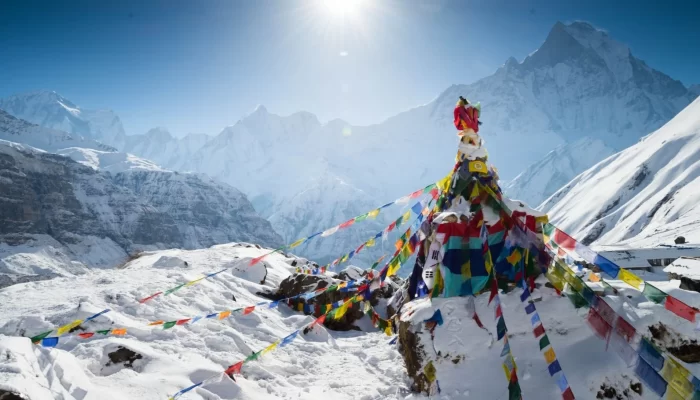
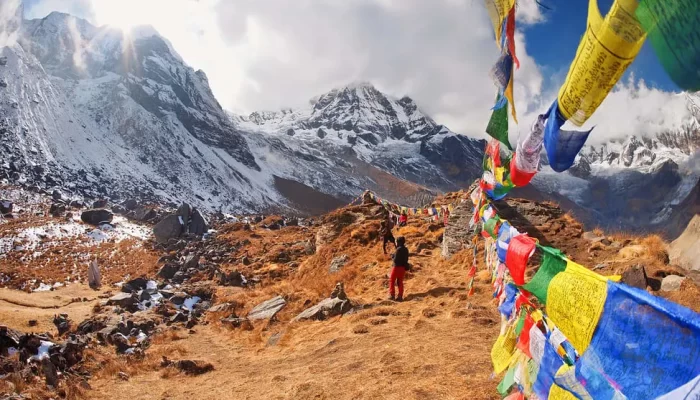
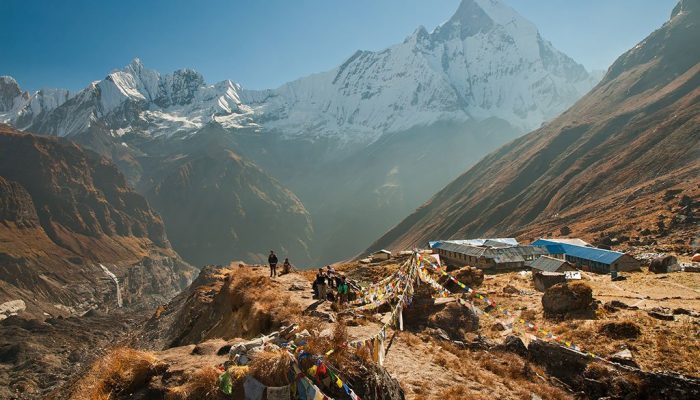
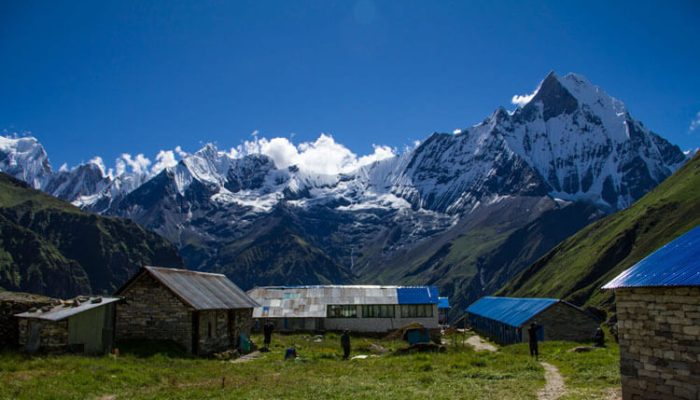
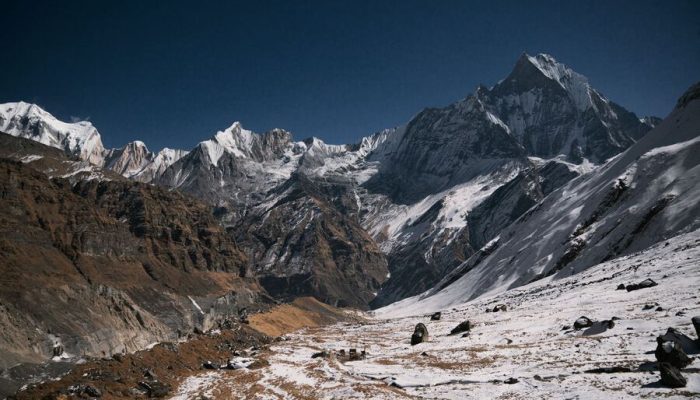
Sample Itinerary
DAY 1
Arrive Kathmandu
Upon arrival at the International airport, meet and assist by our representative and transfer to Hotel.
Kathmandu is the capital of Nepal and the largest urban agglomerate of Nepal. The agglomerate consists of Kathmandu Metropolitan City at its core and its sister cities Patan, Kirtipur, Thimi, and Bhaktapur. According to a census conducted in 2011, Kathmandu metropolis alone has 975,453 inhabitants, and the agglomerate has a population of more than 2.5 million inhabitants. The city stands at an elevation of approximately 1,400 meters (4,600 ft.) in the bowl-shaped Kathmandu Valley of central Nepal.
Rest of the day free in Kathmandu
Overnight at Hotel in Kathmandu
DAY 2
IN KATHMANDU (B)
Breakfast: In the Hotel
AM: Half day sightseeing tour of Swayambhunath and Kathmandu City followed by Rickshaw ride in Thamel
PM: Half day sightseeing tour of Bouddhanath with Lama Interaction and Pashupatinath Temple + interaction with Sadhu and enjoy the evening Aarti at Pashupatinath
Swayambhunath:
The most ancient and enigmatic of the Valley’s holy shrines the golden-spired stupa of Swayambhunath tops a wooded hillock. Records of its history date as far as the 5th century, but its origins are believed to be older. It is the Kathmandu Valley’s most sacred Buddhist shrine and whilst its worshippers include the Vajrayana Buddhists of northern Nepal and Tibet, Newari Buddhists are the most fervent devotees.
Kathmandu Durbar Square:
Kathmandu’s number one tourist attraction swarms with life. Though a few of the square’s 50-plus monuments date from the 12th century, most are from the time of the Malla Kings. Probably the most famous building here is the KumariBahal, a building richly decorated with beautiful woodcarvings, which is home to the Royal Kumari, the Living Goddess, a manifestation of the great goddess Durga. Nearby the former Royal Palace is a Mall Dynasty dwelling, once considerably more extensive than today. Within, the courtyard Nassal Chowk, originally hosted dramatic dance performances, now it is the coronation site of the Shah kings and contains some of the finest wood carvings you will see anywhere in the kingdom.
Rickshaw Ride at Thamel:
Discover Kathmandu like a local as you explore the city on an evening rickshaw ride. Start the tour from Kathmandu Durbar Square and pass buzzing bazaars and market squares as you head to the colorful tourist hub Thamel, where you’ll spend time exploring by the different angels of Nepalese lifestyle, markets and many more. Sit back, relax and be enchanted as you take in views of the sunset, silhouetted temples and Kathmandu’s lively evening.
Later transfer for sightseeing tour of Bouddhanath and Pashupatinath
Bouddhanath:
This great stupa is one of Nepal’s most distinctive monuments and one of the most important Buddhist sites in Nepal and, with a diameter of over 100 meters, amongst the largest in the world. There are a number of legends accounting for the Stupa’s construction, but it is generally believed to date from the 5th century. All Stupas contain holy relics and Bouddha is said to contain the remains of the past Buddha Kasyapa. Bouddha is a particular focus for Kathmandu’s Tibetan community and throughout the day there is a constant stream of people circling the stupa spinning prayer wheels and reciting mantras. Surrounding the stupa are six major monasteries and a host of smaller ones as well as cafes, restaurants and shops selling Tibetan carpets and Newari silversmiths. Boudhanath has now been fully restored and consecrated following the earthquake of 2015.
Visit Monastery for interaction with Lama in Bouddhanath. The Blessing includes the following:
- House/Land Blessing – This is a blessing to promote the health, peacefulness, and productivity of house and land.
- Blessing of Children-This is a blessing that promotes the safety, health and auspicious development of children.
- Anniversary Blessing – This is a blessing to commemorate an event or special occasion.
- Pet Blessing – This a blessing for the sentient beings that people adopt as a loving part of their lives.
Pashupatinath:
This is Nepal’s most sacred Hindu shrine and one of the subcontinent’s great Shiva sites. The supreme holiness of the site stems from the Shiva linga enshrined in its main temple and its location. It expresses the very essence of Hinduism as pilgrims, priests, devotes, temples, ashrams, images, inscriptions and cremation Ghats intermingle with the rituals of daily life, all sprawled along the banks of the sacred Bagmati River. The temple’s origins are obscure, an inscription dates from 477, but a shrine may have stood here for 1000 years before that.
Sadhus in Hinduism are wandering holy men or monks revered for being good. Many Sadhus are also Yogis who are practitioners of meditation. They have chosen a life away from or at least on the edges of normal society to focus on their own spiritual practice. Talking with a Sadhu is said to either be wildly confusing or deeply insightful. Either way being able to speak Hindi is a huge advantage in deciphering what they are saying. However a few Sadhus do understand more English than you might at first have guessed. Sadhu’s are peaceful and do not have any possessions.
Later enjoy the beautiful Aarti ceremony at the bank of Bagmati.
Pashupatinath Temple is regarded as one of the holiest shrines of Hindus across the world. Priests and devotees perform daily ritual worships and offer prayers at the temple in the morning, day and evening time. The evening ‘Aarti’ at the banks of Bagmati River on the eastern side of the temple draws people in hordes. This evening ritual with a band singing hymns in praise of god, playing of classical instruments, chanting of Vedic mantras, ringing of bells, burning of incense, and lighting of oil lamps, keep the people spellbound throughout. The ritual makes the evening environment dazzling. The Aarti is performed at 6 pm every day. The attendees experience a blissful moment.
Overnight at Hotel in Kathmandu
DAY 3
DRIVE KATHMANDU / POKHARA (B) – APPROX. 210 KM / 06-07 HRS. DRIVE
Breakfast: In the Hotel
After breakfast drive to Pokhara
Enjoy Optional white water rafting in the Trishuli River or Visit Manakamana Temple by Cable Car
(Those who don’t want the white water rafting adventure; they can visit Manakamana Temple by Cable Car)
Rafting at Trishuli River:
It is an excellent opportunity to observe the diversity of demography, landscapes, and cultural heritage and the flora and fauna of Nepal. You can experience the thrills of white-water on the course of three days trip. This can be degraded as per your interest and time. For the most of the year the rapids encountered on the Trishuli are straightforward, easily negotiated and well-spaced out. Trishuli River is an excellent river for those looking for a short river trip, without the challenge of huge rapids, but with some really exciting rapids, with beautiful scenery and a relatively peaceful environment. During the monsoon months the intensity of the rapids increases and attracts a radically different set of rafters. There are sections for rafting during the monsoon for those who are looking for simply exciting trip.
Manakamana Temple by Cable Car
The Manakamana Temple situated in the Gorkha district of Nepal is the sacred place of the Hindu Goddess Bhagwati, an incarnation of Parvati. The name Manakamana originates from two words, “mana” meaning heart and “kamana” meaning wish. Venerated since the 17th century, it is believed that Goddess Manakamana grants the wishes of all those who make the pilgrimage to her shrine to worship her. The Manakamana temple lies 12 km south of the town Gorkha.
The temple is located on a distinguished ridge 1,302 metre (4,272 ft.) above sea level and overlooks the river valleys of Trishuli in th south and Marshyangdi in the west. The spectacular views of the Manaslu- Himachali and Annapurna ranges can be seen to the north of the temple. The temple is approximately a 105 kilometres (65 mi) drive from Kathmandu and can also be reached via bus east from Pokhara in around three to four hours. There is a facility of a cable car from Kurintar, just 5 kilometres (3.1 mi) east of Mughling to Manakamana. The cable car rides over the distance of 2.8 kilometres (1.7 mi) in 10 minutes more or less. The cable car usually operates during the daytime from 9 am to 5 pm and stops during lunch break from noon to half past one.
Later proceed to Pokhara
Upon arrival at Pokhara transfer to Hotel
Pokhara is a place of remarkable natural beauty. The enchanting city has several beautiful lakes and offers stunning panoramic views of Himalayan peaks. The serenity of the lakes and the magnificence of the Himalaya rising behind them create the ambience that has made Pokhara such a popular place to relax and enjoy the beauty of nature. Tourism focuses on the districts of Damside and Lakeside (or Pardi and Baidam, in Nepali, respectively).
Overnight at Hotel in Pokhara
DAY 4
DRIVE POKHARA/ JOMSOM (B, L, D) – APPROX. 160 KM / 08-09 HRS. DRIVING
Breakfast: In the hotel
After breakfast we drive to Jomsom by 4wd vehicle via Beni, Tatopani, Lete, Marpha and Tukuche.
First we take a scenic drive to Nayapul and then to the busy town of Beni.From here we start the real adventure with an overland journey on the old Trans-himalayan Salt Trade Route to Tibet.The drive follows the Kaligandaki River most of the way passing through picturesque and traditional Gurung, Magar, Thakali villages of Tatopani, Ghasa and Kalopani with views of waterfalls close by and of stunning views of Annapurna and Dhaulagiri range of mountains that form the world’s deepest gorge of Kaligandaki River.After Kalopani and Lete village we leave the thickly forested area of lower Mustang and proceed to the windswept, barren river valley of Kali Gandaki reaching the charming Thakali tribal villages of Tukuche, Kobang, Marpha and on to Jomsom for our overnight stop.
Lunch at Local restaurant on the way to Jomsom
Upon arrival at Jomsom transfer to Hotel
Jomsom:
North of the Mighty Himalayas lies Jomsom, a mirage on the stark Tibetan plateaus, at 2713 meters.It is the capital and administrative headquarters for Mustang district, which stretches south from the Tibetan border to Ghasa along the Kali Gandaki River. The river cuts deep ridges as it flows between Mt. Dhaulagiri and Annapurna, creating the deepest gorge in the world. This is a land of mystique -where the rugged mountain peaks, like the Annapurna, Nilgiri and Dhaulagiri, gaze down in their awesome splendour at weathered landscapes which contrast with deep river ravines over noisy river beds. Life in Jomsom is a mixture of hard work, social frivolity tempered by culture founded on deep religious traditions. Such close proximity to some of the world’s highest peaks is destined to ingrain a sense of awe about the natural and supernatural. Jomsom is the perfect base from which to make short treks to Kagbeni, Muktinath, and Marpha and also longer treks to the forbidden city of Lo Manthang and of course the popular trek around the Annapurna region.
Dinner and Overnight at Hotel in Jomsom
DAY 5
DRIVE TO KAGBENI VIA MUKTINATH – APPROX. 05-06 HRS. DRIVE
Breakfast: In the hotel
After breakfast, drive to Muktinath
Muktinath is a reverred shrine for salvation seekers. Mukti mean Salvation and Nath means lord and so it holds great significance for all spiritual people in the South Asian Sub-continent. Muktinath (the provider of salvation) has been one of the famous Himalayan shrines where thousands of devotees flock for attaining the much sought after moksha (freedom) from the cycle of birth and rebirth.
After Muktinath drive to Kagbeni for Lunch
Kagbeni has the look and feel of its northern neighbour Tibet, and is known as the “Gateway to Upper Mustang.” The town of Kagbeni sits at the bottom of Muktinath Valley which is scattered with abandoned settlements and irrigation fields. The centerpiece of Kagbeni is its fortress ruins. In the second half of the 16th century, before the establishment of the village, Muktinath Valley’s king built his son a fortress at the convergence point of four trade routes. This strategic location allowed the king to levy taxes on the commodities and animals that passed through the valley. After lunch enjoy a short hike around Kagbeni: Kagbeni Monastery and Buddhist School, Kaligandaki gorge (world’s deepest gorge), Kaligandaki River, Buddhist monastery in Jharkot, Incredible views of Dhaulagiri, Nilgiri and Tukuche Peak and local activities.
Dinner and Overnight at Hotel in Kagbeni
DAY 6
DRIVE TO GHILING – APPROX. 06 HOURS. DRIVE
Breakfast: In the hotel
Drive to Ghiling Village Crossing Kaligandaki River and pass by the ancient Buddhist Stupa, Chuksung Village, Chella Village, Samar Village, and Syangboche during the drive to Ghiling.
Lunch at Local Restaurant in Syangboche
After lunch continue driving to Ghiling
Ghiling is the first important settlement along the road to Lo Manthang at about 30 Km south of the Capital. It is particularly interesting because of the position of the main monastery, high up the hill, while the village itself is largely situated in the plain below. Additionally, the village is marked by a much less dense urban pattern than the other settlements of the region, with large courtyard houses spread in open spaces with a lot of greenery.
Upon arrival at Ghiling, transfer to a local lodge.
Dinner and overnight at local lodge in Ghiling
DAY 7
DRIVE TO LO MANTHANG – APPROX. 04 HOURS. DRIVE
Breakfast: In the hotel
Drive to Lo Manthang via Ghami and Charang
Lo Manthang is the capital of former Kingdom of Lo and has been built on a 3880 m high plateau. The town is surrounded by a 6-meter high wall with square towers or dzong on the corners. This isolated Tibetan settlement was founded in 1380 and was the capital of the former Kingdom of Lo. Within the walled fortress there exists a compact settlement of about 200 earthen structures including palaces and monasteries. The inner city with the palace and about 30 dwellings is walled and the gates are still locked every night. There are four major temples within the city and one of these, Champa Lhakhang, contains a huge clay statue of Buddha as well as elaborates mandalas painted on the walls. The king’s palace is an imposing building in the centre of the city. Although his duties are largely ceremonial, the King is respected by the people.
Lunch at Local Restaurant in Lo Manthang
Explore Lo Manthang – Capital of the Forbidden Kingdom
Dinner and overnight at local lodge in Lo Manthang
DAY 8
DRIVE TO CHHOSER – APPROX. 04 HOURS. DRIVE
Breakfast: In the hotel
Drive to Chhoser to explore Chhoser Monastery, Khangchuling cave, Jhong cave, NYFU Monastery, Chhonup Village, Nymagel Village and Tingkar Village, Namgyal Monastery and Summer Palace and local activities.
Chosar is a cave village, with the deep-red Nyphu Gumpa built into the rock face at 3760 meters. Past the Gumpa is an incredible cave-dwelling site called Jhong Cave which you negotiate by ladders and through small tunnels, very interesting and reputed to be 2,500 years old. In front of us, a range of spectacular snow-peaks marks the border with Tibet, and around us gurgling streams and green meadows line our trail. If we take the long loop, we can stop at Nyamdo Gompa, ride over a small pass and then head back down the western valley to Lo. The Chosar valley was the main trading route with Tibet and Lhasa, and is peppered with the ruins of old fortresses guarding this strategic valley.
After exploring Chosar Village we return Lo Manthang
Dinner and overnight at local lodge in Lo Manthang
DAY 9
DRIVE TO JOMSOM – APPROX. 07 HOURS. DRIVE
Breakfast: In the hotel
After breakfast drive back to Jomsom
Rest of the day free at Jomsom for explore and shopping
Dinner and overnight at Hotel in Jomsom
DAY 10
FLY TO POKHARA – APPROX. 20 MINUTE FLIGHT
Breakfast: In the hotel
After breakfast fly to Pokhara
Upon arrival at Pokhara transfer to Hotel
Half day sightseeing of Pokhara city and one hour boating at Fewa Lake
Overnight at Hotel in Pokhara
DAY 11
DRIVE TO KATHMANDU – APPROX. 210 KM / 6-7 HOURS’ DRIVE
Breakfast: In the hotel
After breakfast drive to Kathmandu
Upon arrival at Kathmandu transfer to Hotel
Rest of the day free for explore and shopping
Overnight at Hotel in Kathmandu
DAY 12
DEPARTURE
Breakfast: In the hotel
Free till the time of Departure
Transfer to Tribhuwan International Airport for Departure.
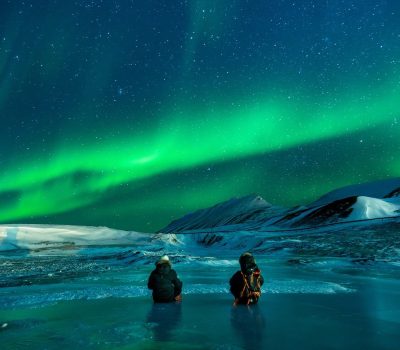
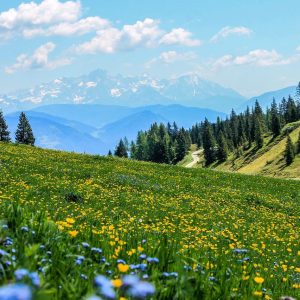
CREATE AN EXPERIENCE
Let's Make Memories Together
The voyage does not finish once you have left. We’ll transport you to a world of wonders and create amazing memories that will last long after you’ve returned home.
Away from the regular tourist traps, you’ll have a one-of-a-kind, authentic experience. A sensation created in an energizing setting that will be yours and yours alone. We will make this happen because old travels are great ones. The world’s wonders are within your grasp.





